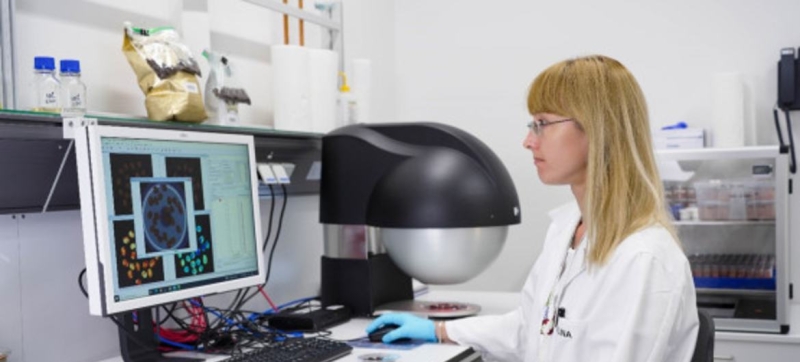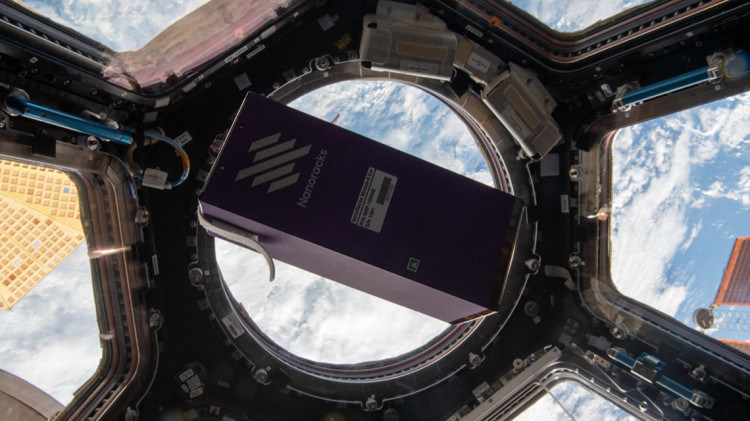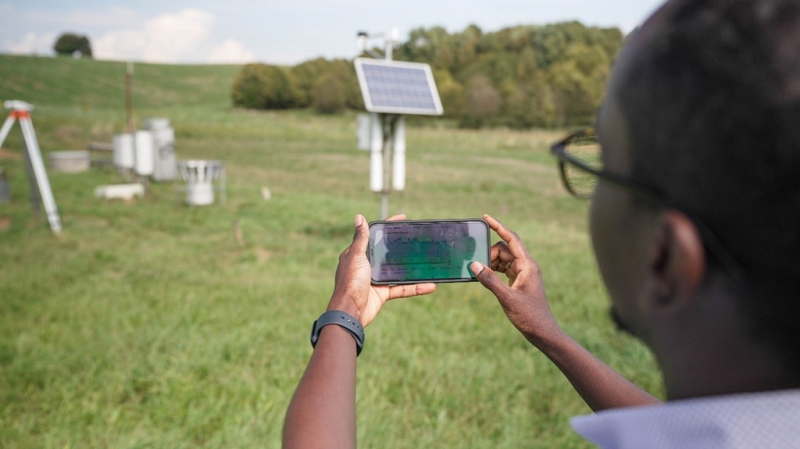
A worker at the Joint FAO/IAEA Centre for Nuclear Techniques in Food and Agriculture’s Food Safety and Control Laboratory uses multispectral imaging to identify Arabica coffee beans that have been adulterated for economic gain. FAO-IAEA Partnership Turns 60 Matteo Louis Casling Economic Development
The Joint FAO/IAEA Centre for Nuclear Techniques in Food and Agriculture celebrated its 60th anniversary in 2024. Launched in 1964, this partnership between the Food and Agriculture Organization of the United Nations (FAO) and the IAEA promotes the use of nuclear science to improve food security, agricultural productivity and environmental sustainability.
For the past six decades, the Joint FAO/IAEA Centre has been using nuclear technology to help countries address some of the world’s most pressing challenges, offering solutions to increase crop yields and protect livestock health, control insect pests, improve soil and water management practices, and ensure the safety and authenticity of food.
Since its establishment, the Joint FAO/IAEA Agriculture and Biotechnology Laboratories have been at the core of the Joint FAO/IAEA Centre. These state-of-the-art laboratories form the backbone of all the Joint FAO/IAEA Centre’s activities, developing technologies that contribute to solving a variety of agricultural and environmental problems. Today, the laboratories remain at the cutting edge of science, technology and innovation, and continue to provide countries with cutting-edge research, capacity development and technology transfer.
Since its establishment, the Joint FAO/IAEA Centre has made a significant contribution to improving agriculture and food systems by applying nuclear science and techniques in its five key areas of work.
Insect Pest Management
The Joint FAO/IAEA Centre is actively promoting the further development and application of the sterile insect technique (SIT) and other radiation-based technologies for pest control. SIT has been a core activity of the Joint FAO/IAEA Centre since its establishment, enabling effective control of insect pests and the reduction or elimination of the use of chemical pesticides. SIT involves the sterilization of male insects of target species using ionizing radiation. In Fort Myers, Florida, United States of America, SIT is being used to suppress mosquito populations that have developed resistance to insecticides.
In 2024, SIT played a key role in the eradication of the Mediterranean fruit fly in the Dominican Republic, following an initial eradication of the fly in 2017 and its subsequent resurgence. The MSN helped the country regain access to important export markets.

Tsetse fly rearing at the Insect Pest Control Laboratory of the Joint FAO/IAEA Centre.
Plant Breeding and Genetics
One of the key areas of work of the Joint FAO/IAEA Centre is to improve mutation breeding for the development of plants with improved characteristics. This technique involves irradiating plant seeds and other plant materials to accelerate the natural mutation process. This results in the development of desirable genetic variants that improve agricultural productivity.
To facilitate cooperation and knowledge sharing among countries, the Joint FAO/IAEA Centre maintains the FAO/IAEA Mutant Varieties Database, a comprehensive repository of information on officially released mutant crop varieties. As of 2024, the database contains information on 3,433 improved mutant varieties belonging to more than 200 plant species released worldwide.
In 2022, the Joint FAO/IAEA Centre sent seeds to the International Space Station to study the effects of space radiation and microgravity on plant genetics. Scientists are currently studying cosmic ray-induced mutations to identify traits that could help make crops more resilient to climate change.

Seeds from The Joint FAO/IAEA Centre laboratories were launched into space on 7 November 2022.
Soil and Water Management
Nuclear and isotopic techniques are valuable tools for quantifying and improving soil fertility and plant nutrition. The joint FAO/IAEA centre develops and shares solutions for measuring and monitoring processes that characterize soil-water-nutrient interactions to improve the productivity and sustainability of cropping systems. The centre also plays a leading role in efforts to combat soil pollution and restore the environment, addressing issues such as heavy metal accumulation, antimicrobial resistance, microplastic pollution and radioactive contamination.
Using nitrogen-15 isotopic techniques, scientists at the Joint FAO/IAEA Centre trained local researchers and farmers in the Lao People’s Democratic Republic to optimize fertilizer applications while efficiently using rice straw and manure as a nutrient source. Field trials on local farms demonstrated significant increases in rice yields, contributing to food security in a country whose population relies heavily on rainfall-dependent rice cultivation. The initiative not only increased agricultural productivity, but also promoted sustainable agricultural practices, which are critical to the sustainability of the country’s agricultural sector.
Accurate soil moisture data from instruments such as the Cosmic Ray Neutron Source (CRNS) has the potential to change the way we manage water resources. By measuring natural neutrons in soil, CRNS enables accurate, large-scale monitoring of soil moisture in real time.
Animal Production and Health
The joint FAO/IAEA centre plays an important role in advancing animal production and health sciences using nuclear and related techniques. The centre’s work helps improve livestock productivity and feed efficiency, as well as the diagnosis and treatment of animal diseases, leading to safer and more efficient livestock production systems.
In August 2020, with support from the Joint FAO/IAEA Centre, laboratories in Bosnia and Herzegovina and Serbia successfully performed genome sequencing to characterize the COVID-19 virus. Using this real-time reverse transcription–polymerase chain reaction (RT-PCR)-based technique, researchers were able to trace the origin of the virus and analyze its transmission patterns. With their experience in zoonotic diseases, the veterinary laboratories were particularly well-prepared for the research, could effectively plan responses, and share critical data on virus mutations.
To combat transboundary animal and zoonotic diseases, the Joint FAO/IAEA Veterinary Diagnostic Laboratory Network (VETLAB network) strengthens the capacity of veterinary laboratories in countries, particularly in Africa and Asia. VETLAB helps national veterinary diagnostic laboratories share expertise and information and organize training for their staff. The network also helps improve preparedness for animal and zoonotic disease outbreaks by harmonizing regional approaches to early disease detection and reporting.

In the background, a probe with a cosmic ray neutron detector is transmitting real-time data on soil moisture content to a mobile phone.
Food Safety and Quality Control
The IAEA and FAO help countries combat food fraud by identifying harmful contaminants and ensuring the authenticity and quality of food products.
For example, Vietnam has been able to significantly increase food exports by using food irradiation techniques. Such techniques effectively prevent the spread of transboundary insect pests and destroy microorganisms that can spoil food, ensuring that safe food reaches consumers.
Another example of the Joint FAO/IAEA Centre’s work in food safety is the assistance it has provided to the Food Safety and Quality Laboratory in Sri Lanka since 2001. The aim of this work is to develop advanced testing methods for the detection of aflatoxins, dangerous contaminants produced by fungi on crops such as maize and groundnuts. Nuclear techniques are used to monitor aflatoxin contamination of foods and play a key role in informing national food safety regulations. This helps to ensure that contaminated food does not enter the marketplace and protects local and international consumers from potential health risks, including cancer.
In Bangladesh, the Joint FAO/IAEA Centre trained scientists at the Veterinary Drug Residue Analysis Laboratory (VDRL) in areas such as testing foods for a range of hazards, screening and testing for chemical residues and contaminants in foods. The VDRL now uses a variety of isotopic and nuclear analytical tools and techniques to detect antimicrobial residues and mycotoxins in foods of animal and plant origin. Capacity building is also underway in microbiological testing of foods, including testing for zoonotic diseases that may be transmitted by such foods. Every year, with the support of the Joint FAO/IAEA Centre, more than 3,000 food samples, including eggs, milk, chicken and shrimp, are analysed to generate a data set on chemical residues in food.
To combat food fraud, the Joint FAO/IAEA Centre develops and transfers nuclear technologies to partners to detect counterfeit food. For example, with the support of the Joint FAO/IAEA Centre, scientists from the Jožef Stefan Institute in Slovenia used isotope analysis to detect fake white truffles. This technique helps to determine the origin of truffles and effectively prevent their adulteration.
60 Years of Innovation and Collaboration
The 60th anniversary of the Joint FAO/IAEA Centre provides an opportunity to reflect on its pioneering legacy and collaborative spirit – and on the key role of science and international cooperation in addressing global challenges to transform agriculture and food systems. The Joint FAO/IAEA Centre seeks solutions to increase access to healthy and safe food for the world’s growing population, while minimizing the environmental impact of agriculture and mitigating the threats of climate change.
In 2023, at the World Food Forum, the IAEA and FAO launched the Atoms4Food initiative, which aims to increase global food production and improve nutrition. The initiative involves tailor-made country approaches to address diverse food and agricultural challenges and the introduction of innovative nuclear techniques to enhance agricultural productivity and the sustainability of agri-food systems, increase food production, ensure food safety and mitigate the challenges of climate change.
The Joint FAO/IAEA Centre will remain a force for innovation and will continue to provide effective solutions to the ever-evolving agricultural challenges facing humanity through the promotion of research for development, capacity building, knowledge sharing and partnerships.
Historic Achievements
While many of the Joint FAO/IAEA Centre’s notable achievements have been in its more recent years, the Centre has six decades of experience developing and applying valuable nuclear techniques that have had a significant impact on the field. Examples of such activities include a tsetse fly control project in Nigeria, initiated in 1979, which eradicated the pest from the entire area by 1987; the conversion of salt-affected soils in Pakistan into productive farmland following the introduction of salt-tolerant varieties of barley and wheat in 1978; and the contribution to the eradication of rinderpest in the early 1980s.
